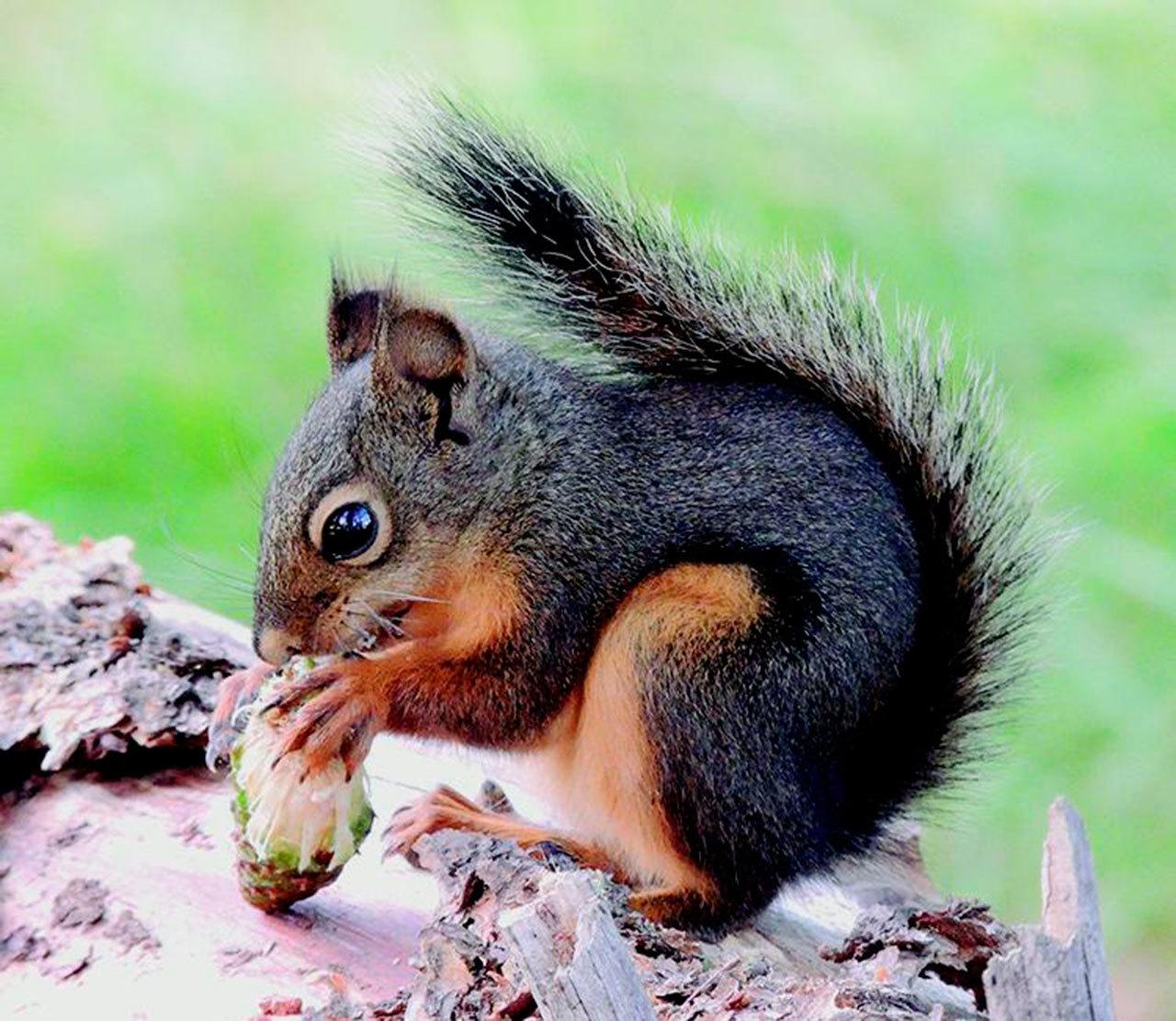Up close I can hear the rough snicketing sound of claws and teeth on skin when they fall in a whirling ball from the coveted sunflower seed dispenser. A couple of by now tattered Douglas squirrels have been bickering over the turf that includes the birdfeeder outside the window here. It can’t be fun for them, but the dedicated fury in such a small package makes me laugh anyway. Sorry.
Here in the Northwest they’re pretty successful rodents of coniferous forests from the Cascades west to the Olympic Peninsula. They’re mostly arboreal (spend most of their time in the trees), diurnal (daytime) and supremely agile. They’ll scramble in a blur to the opposite side of a tree when surprised, then poke their heads around the edge to give you a scolding that sometimes lasts long after you’ve passed. (I’ve never been able to figure how drawing so much attention to themselves pencils out, but apparently it does.) If you hang around quietly, they’ll pretty quickly figure out how slow you are and often will return to business right at your feet.
Amazingly, there are plenty of predators that eat them like popcorn: fishers, martens, owls, goshawks, etc., and occasionally a lucky bobcat or coyote, but they don’t seem to put much of a dent in the population. I’ve read that they’re also highly regarded by squirrel-hunters of the human variety, but at only about 6 ounces live weight, they can’t be much more than an hors d’oeuvre.
Douglas squirrels also are called chickarees and eat just about anything: twig tips, flowers, mushrooms, insects, bird eggs, baby birds, catkins, etc., even spawned-out salmon, and have quite a sweet tooth for berries and sap, but cone seeds probably provide the bulk of their diet.
It’s too much work to climb up and down for each cone, so squirrels will cut a bunch of them down at a time (about 10-15 a minute by my count), and then hustle around on the ground to pack them away for cool, moist storage somewhere underground. The moistness apparently keeps the cones from ripening and opening.
They trim big cones like from grand firs to a manageable weight before hauling them off to storage. (Who knows how they keep from getting covered in pitch!) Stored cones are taken out later to be dismantled and the seeds eaten. Nice perches with a bit of view often disappear under huge piles (middens) of cone detritus. Big middens are then sometimes tunneled out for more storage space.
Douglas squirrels also like fungi and often dig up underground-fruiting truffles (they and flying squirrels are these fungi’s primary means for spreading spores around). Mushrooms tucked in tree branches to dry before storage is evidence of a busy squirrel.
They’ll move from the summer’s nest of twigs and leaves to somewhere warmer for the winter, like some tree hollow or a woodpecker nest. With all the cones and mushrooms stored away, there’s no point in hibernating, so Douglas squirrels are active all year. They lay around indoors a lot in nasty weather snoozing and belching and farting on a pile of food, venturing out only if they feel like it. In town they sometimes winter in birdhouses and make a living robbing birdfeeders (like mine). A friend of mine calls them dayrats, only half in jest.
Squirrels chasing each other are sometimes young siblings playing. Adults are pretty territorial, though, and will chase, attack and sometimes even kill intruding squirrels.
Young Douglas squirrels (3-6/litter born in spring) usually live with their mother through their first winter, which is unusual. Most small rodents are on their own much earlier. I’ve heard that if a litter fails for some reason, the parents will try again as late as August.
Their home ranges are usually only an acre or two but every nook, cranny, branch and knothole is well known and used in escapes when necessary. They have astonishing leaping ability, as I’m sure you know. Occasionally they miscalculate and fall, but are apparently able to survive long falls of over a 100 feet by twisting to horizontal and extending limbs and tail. (A landing in soft forest duff probably helps.)
They range over most of western North America, from southern Yukon south into central California. The closely related red squirrel inhabits the Rockies and ranges north to Alaska and east to the Atlantic.
Tom Butler has a degree in zoology from the University of Washington and is a lifelong student of nature. He lives in Port Angeles and can be reached at butlert@olypen.com.



